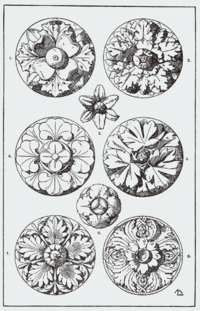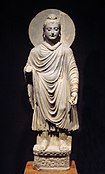Rosette (design)

Arosetteis a round,stylizedflower design.
Origin[edit]
The rosette derives from the natural shape of thebotanical rosette,formed by leaves radiating out from the stem of a plant and visible even after the flowers have withered.
History[edit]
The rosette design is used extensively in sculptural objects fromantiquity,appearing inMesopotamia,and in funeralsteles' decoration inAncient Greece.The rosette was another important symbol of Ishtar which had originally belonged to Inanna along with theStar of Ishtar.[1]
It was adopted later inRomanesequeandRenaissancearchitecture, and also common in the art ofCentral Asia,spreading as far as India where it is used as a decorative motif inGreco-Buddhist art.
Ancient origins[edit]
One of the earliest appearances of the rosette in ancient art is in early fourth millenniumBCEgypt.[2]Another earlyMediterraneanoccurrence of the rosette design derives fromMinoanCrete;Among other places, the design appears on thePhaistos Disc,recovered from theeponymousarchaeological site in southern Crete.[3]
-
Thalea funerary stele with three rosette designs at the top, fromc. 150BCE.Hellenisticwork fromSmyrna(nowİzmir,Turkey).
-
Rosette design at the bottom of a statue of theBuddha,circa 1st centuryCE.Greco-Buddhistart found inGandhara
Modern use[edit]
The formalised flowermotifis often carved in stone or wood to createdecorative ornamentsfor architecture and furniture, and inmetalworking,jewelry designand theapplied artsto form a decorative border or at the intersection of two materials.
Rosette decorationshave been used for formalmilitary awards.They also appear in modern, civilian clothes,[4]and are often worn prominently in political[5]or sporting[6]events. Rosettes sometimes decorate musical instruments, such as around the perimeter of sound holes ofguitars.
Gallery[edit]
-
Mohenjo-daropriest
-
Mesopotamian,Sumerianbull
See also[edit]
Footnotes[edit]
- ^Black, Jeremy; Green, Anthony (1992), Gods, Demons and Symbols of Ancient Mesopotamia: An Illustrated Dictionary, The British Museum Press,ISBN0-7141-1705-6,p. 156
- ^Haddon, Alfred Cort.Evolution in Art: As Illustrated by the Life-histories of Designs,1914, Scribner's, 364 pages
- ^"Phaistos Fieldnotes"by C.Michael Hogan,The Modern Antiquarian,2007
- ^"Blame the Rosettes"by Eric Wilson,The New York Times,3 August 2006
- ^Seerosette in politics
- ^Woodward, Kath.Social Sciences: The Big Issues,Routledge; 2nd edition: September 2009;ISBN978-0415466608










